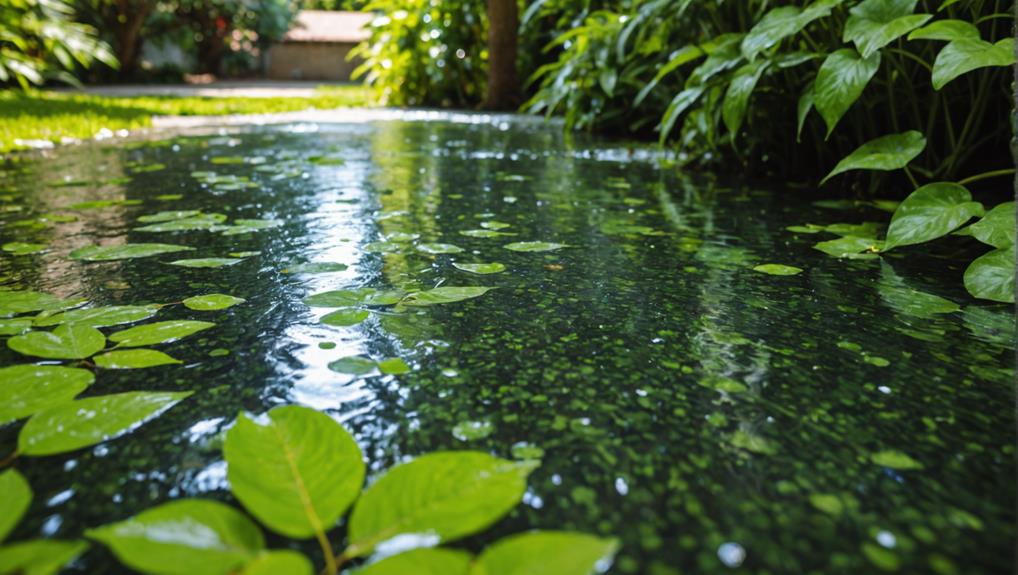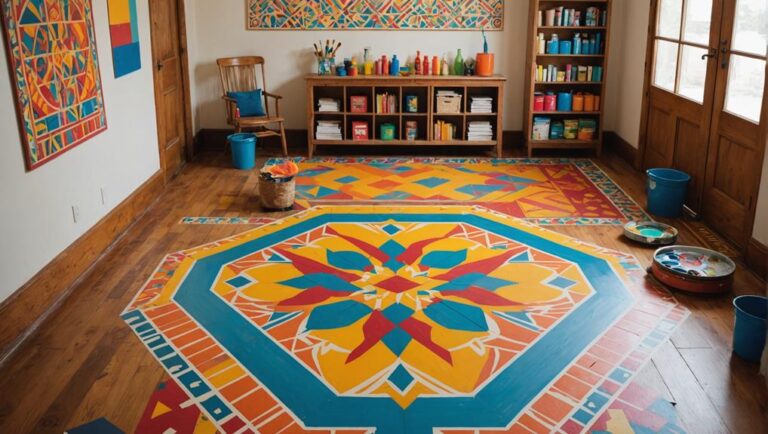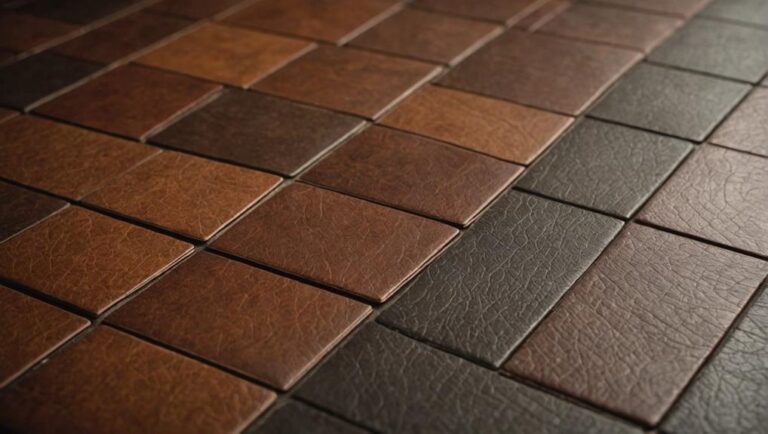When you're looking for waterproof sealants for outdoor floors, it's crucial to take durability and moisture resistance into account. Acrylic sealants provide flexibility and are easy to apply, while polyurethane sealants offer high durability for extreme weather. Both types create a robust barrier against moisture, molds, and UV damage, enhancing safety and reducing maintenance. Make sure you properly prepare the surface before application, and be aware of reapplication needs based on environmental conditions. By choosing the right sealant, you can markedly extend the lifespan of your outdoor flooring. There's more important information available to help you make the best choice.
Importance of Waterproof Sealants
Waterproof sealants are often essential for maintaining the longevity and integrity of outdoor floors. When you invest in outdoor flooring, you need to take into account the impact of moisture on its lifespan. Without proper moisture protection, water can penetrate the surface, leading to structural damage, mold growth, and eventual deterioration. This not only affects the appearance but also compromises safety, as slippery surfaces can pose a risk for falls.
Using a high-quality waterproof sealant enhances sealant longevity, ensuring your outdoor flooring withstands harsh weather conditions. Sealants create a protective barrier that prevents moisture from seeping into the material, effectively reducing the risk of damage from rain, snow, and ice. By applying these sealants, you're investing in the durability of your flooring, which can save you from costly repairs or replacements in the future.
Moreover, the application of a waterproof sealant can greatly reduce maintenance efforts. You'll find that cleaning becomes easier, as dirt and debris are less likely to adhere to a well-sealed surface. This not only preserves the aesthetic appeal of your outdoor area but also contributes to a safer environment, as less grime can mean reduced slipperiness.
Types of Waterproof Sealants
When selecting a waterproof sealant for your outdoor floors, you'll encounter various options, primarily acrylic and polyurethane sealants. Acrylic waterproof sealants are known for their ease of application and quick drying times, while polyurethane sealants offer superior durability and flexibility. Understanding these differences will help you choose the right product for your specific needs.
Acrylic Waterproof Sealants
Acrylic waterproof sealants are among the most versatile options available for outdoor flooring applications. These sealants feature an acrylic formulation that provides excellent protection against water intrusion while maintaining flexibility. This flexibility is vital for outdoor durability, as it allows the sealant to expand and contract with temperature changes without cracking.
When applying an acrylic waterproof sealant, it is important to verify the surface is clean and dry to achieve the best adhesion. These sealants are typically easy to apply, either by brush, roller, or spray, making them user-friendly for DIY projects. Once cured, they create a protective barrier that resists mold, mildew, and UV damage, enhancing safety by reducing slippery surfaces.
Acrylic sealants also offer a range of finishes, allowing you to choose one that suits your aesthetic preferences while retaining their functional benefits. They dry quickly and are usually water-based, making cleanup straightforward and environmentally friendly. Additionally, their low VOC (volatile organic compounds) content contributes to better indoor air quality.
Polyurethane Waterproof Sealants
Polyurethane waterproof sealants are highly regarded for their exceptional durability and chemical resistance, making them ideal for outdoor flooring applications. Their polyurethane properties allow them to withstand extreme weather conditions, UV exposure, and heavy foot traffic, guaranteeing long-lasting protection for your surfaces.
When applying polyurethane sealants, it is vital to follow specific application techniques for best results. First, verify the surface is clean, dry, and free of any contaminants. You might want to use a primer for better adhesion, particularly on porous surfaces. Apply the sealant evenly with a brush or roller, and avoid overworking it to prevent bubbles. It's important to work in manageable sections, allowing each area to cure properly before moving on.
Curing times can vary, so always refer to the manufacturer's guidelines for specific instructions. For safety, wear protective gear, including gloves and a mask, to minimize inhalation of fumes. Additionally, confirm proper ventilation during application. By following these guidelines, you can effectively utilize polyurethane waterproof sealants, guaranteeing your outdoor floors remain protected and visually appealing for years to come.
Benefits of Using Sealants
Sealants provide a robust barrier against moisture, considerably enhancing the longevity of outdoor floors. By applying sealants, you're not just protecting the surface; you're investing in durability enhancement and moisture resistance. This means fewer repairs and replacements over time, ultimately saving you money and effort.
Here's a quick overview of the key benefits of using sealants:
| Benefit | Description | Impact on Safety |
|---|---|---|
| Durability Enhancement | Sealants strengthen the surface, preventing cracks and wear. | Guarantees a safer, more stable walking surface. |
| Moisture Resistance | Creates a waterproof layer, keeping moisture at bay. | Reduces the risk of slip hazards from water accumulation. |
| UV Protection | Shields the flooring from harmful UV rays. | Prevents surface degradation and maintains traction. |
| Stain Resistance | Repels spills and stains, making maintenance easier. | Keeps surfaces cleaner, reducing potential health risks. |
| Cost-Effectiveness | Less frequent repairs lead to lower long-term costs. | Provides peace of mind knowing your investment is protected. |
Utilizing sealants not only enhances the aesthetic quality of your outdoor flooring but also contributes to a safer environment. With moisture resistance, you diminish the chances of mold or mildew growth, which can pose health risks. To summarize, the benefits of using sealants are clear: they provide a protective barrier that guarantees your outdoor floors remain functional and safe for years to come.
How to Choose the Right Sealant
Choosing the right sealant for your outdoor floors can greatly impact their performance and longevity. To guarantee you select a sealant that meets your needs, consider the following key factors:
- Sealant Characteristics: Look for sealants that offer resistance to UV rays, moisture, and temperature fluctuations. These characteristics help protect the surface from deterioration and guarantee lasting durability.
- Surface Compatibility: Confirm the sealant is compatible with the material of your outdoor floor, whether it's concrete, wood, or stone. Different surfaces may require specific formulations to achieve ideal adhesion and performance.
- Application Environment: Consider the climate and environmental conditions in your area. Some sealants are designed for extreme weather conditions, while others may perform better in milder climates. Choose one that suits your environment to maximize protection.
- Safety Standards: Always check for certifications or ratings that indicate the sealant meets safety standards. This is especially important if you'll be using the area for activities involving children or pets, as some chemicals can be hazardous if not properly evaluated.
Application Process for Sealants
Once you've selected the right sealant for your outdoor floors, understanding the application process is key to achieving ideal results. Proper surface preparation is critical; it guarantees that the sealant adheres effectively and provides long-lasting protection. Start by cleaning the surface thoroughly, removing any dirt, grease, or debris. A pressure washer can be particularly effective for this purpose, but make sure the surface is completely dry before proceeding.
Next, inspect for cracks or damages. If you find any, repair them with an appropriate filler, allowing ample time for the repairs to cure. Once the surface is clean and repaired, it's time to apply the sealant. Use suitable application techniques, such as a roller or sprayer for large surfaces, and a brush for edges and tight spots. Always follow the manufacturer's instructions regarding application thickness and coverage rates.
When applying, work in small sections to maintain a wet edge, which helps avoid unsightly lap marks. Confirm you apply the sealant evenly, taking care not to leave puddles or thick spots, as these can lead to peeling or bubbling. After application, allow the sealant to cure as recommended, avoiding foot traffic and moisture during this period. Adhering to these steps not only confirms a smooth finish but also maximizes the protective qualities of your sealant, keeping your outdoor floors safe and visually appealing for years to come.
Maintenance Tips for Sealed Floors
To guarantee your sealed outdoor floors remain effective, it's crucial to establish a regular cleaning schedule that prevents dirt and debris buildup. You'll also need to follow reapplication frequency guidelines to maintain the integrity of the sealant over time. By adhering to these practices, you'll extend the life of your waterproof sealant and protect your investment.
Regular Cleaning Schedule
Establishing a regular cleaning schedule is essential for maintaining the integrity and appearance of sealed outdoor floors. Routine maintenance helps prevent dirt, debris, and moisture from compromising the sealant, ensuring your outdoor surfaces remain safe and visually appealing. Here are some key steps to include in your cleaning schedule:
- Weekly Sweeping: Remove loose dirt and debris to prevent scratching the surface and promote proper drainage.
- Biweekly Washing: Use a mild detergent mixed with water to wash the floors, ensuring you rinse thoroughly to avoid soap residue.
- Monthly Inspection: Check for any signs of wear or damage, paying close attention to areas that may trap water or debris.
- Annual Deep Clean: Consider a professional deep cleaning to restore the surface, especially if stains or discoloration are present.
Reapplication Frequency Guidelines
Maintaining the appearance and functionality of sealed outdoor floors goes beyond regular cleaning; it also involves timely reapplication of sealants. Generally, you should plan to reapply sealants every one to three years, but this can vary based on several factors. Pay attention to reapplication indicators such as visible wear, discoloration, or a change in texture. If water no longer beads on the surface, it's likely time for a reapplication.
Seasonal factors play an essential role in determining the appropriate schedule for reapplication. For instance, areas with heavy rainfall or extreme temperature fluctuations may require more frequent sealant applications than milder climates. Additionally, the type of sealant used can affect longevity; some products are formulated for extended durability in outdoor conditions.
To guarantee safety, always follow the manufacturer's guidelines regarding application and reapplication. Regular inspections will help you detect potential issues early. By keeping an eye on these indicators and understanding how seasonal factors impact your sealed floors, you can maintain their integrity and guarantee a safe, functional outdoor space.
Common Mistakes to Avoid
While applying waterproof sealants for outdoor floors can greatly enhance their durability, several common mistakes can undermine your efforts. Avoiding these pitfalls is essential to guarantee that your sealant performs as intended and protects your surfaces effectively.
Here are four common mistakes you should steer clear of:
- Ignoring Surface Preparation: One of the most frequent application errors is failing to properly prepare the surface. Make sure the floor is clean, dry, and free of any debris or previous coatings that could interfere with adhesion.
- Applying in Poor Weather Conditions: Many people have the misconception that sealants can be applied anytime. However, high humidity, rain, or extreme temperatures can affect the curing process, leading to subpar results.
- Over-application: It's easy to think that more sealant means better protection, but this is a common misconception. Applying too thick a layer can cause bubbling or peeling. Follow the manufacturer's guidelines for the right amount to use.
- Neglecting to Test First: Before applying sealant to the entire surface, always test a small, inconspicuous area. This step helps you identify any potential issues with adhesion or compatibility.
Environmental Considerations
When selecting waterproof sealants for outdoor floors, it is crucial to take into account their environmental impact. You want to choose products that not only protect your surfaces but also align with sustainability practices. Eco-friendly options can minimize harmful chemicals entering the environment, ensuring a safer habitat for you and your loved ones.
Here's a useful comparison of different sealant types based on their environmental impact:
| Sealant Type | Environmental Impact | Eco-Friendly Rating |
|---|---|---|
| Acrylic Sealants | Low VOC emissions | High |
| Polyurethane Sealants | Moderate VOC emissions | Medium |
| Epoxy Sealants | High durability, but high VOC emissions | Low |
| Natural Oils | Biodegradable, non-toxic | Very High |
By examining these factors, you can make informed decisions that align with your commitment to sustainability. Acrylic sealants, for example, offer a good balance of performance and minimal environmental impact, while natural oils provide a highly eco-friendly option.
When applying sealants, consider the potential for runoff and how it may affect local water sources. Also, avoid products containing heavy metals or harmful solvents, as these can pose long-term risks to both health and the environment.
Top Waterproof Sealant Products
For homeowners and contractors seeking reliable protection for outdoor floors, selecting the right waterproof sealant is fundamental. With numerous options available, understanding the top products can help you make an informed decision. Here's a quick overview of four highly-rated waterproof sealants, along with their application techniques and considerations for product comparisons.
- Thompson's WaterSeal: Known for its strong water-repellant properties, this sealant is easy to apply with a sprayer or roller. It's ideal for wood and concrete surfaces, providing long-lasting protection.
- Behr Premium Concrete & Masonry Sealant: This product offers excellent durability and resistance against mold and mildew. Its application techniques involve using a brush or roller, guaranteeing an even coat on porous surfaces.
- Rust-Oleum EPOXYShield: Specifically designed for garage floors, it provides a tough, waterproof barrier. Its application requires meticulous surface preparation, including cleaning and etching, to guarantee maximum adhesion.
- Drylok Masonry Waterproofer: Designed for concrete and masonry, it's ideal for basements and outdoor areas. Applying this sealant involves using a brush or roller, and it's important to follow the manufacturer's guidelines for best results.
When making product comparisons, consider factors like drying time, ease of application, and long-term performance. Proper surface preparation and adherence to application techniques are essential for guaranteeing safety and effectiveness in protecting your outdoor floors.
Frequently Asked Questions
How Long Does a Waterproof Sealant Typically Last Outdoors?
When considering how long a waterproof sealant typically lasts outdoors, you need to factor in sealant durability and environmental factors. Generally, a quality sealant can last anywhere from 3 to 10 years, but exposure to UV rays, moisture, and temperature fluctuations can greatly impact its lifespan. Regular maintenance and reapplication can help guarantee ideal protection, so keeping an eye on your sealant's condition is essential for maintaining safety and effectiveness.
Can I Apply Sealant in Cold Weather Conditions?
Imagine trying to paint a masterpiece in a snowstorm; applying sealant in cold weather isn't ideal. Sealant temperature guidelines usually recommend temperatures above 50°F for best adhesion. If it's too cold, the sealant may not cure properly, leading to potential failures. Always check the product specifications for cold weather application. It's vital for safety and durability to guarantee the right conditions before you begin sealing your surfaces.
Are There Any Color Options for Waterproof Sealants?
Yes, there are color options for waterproof sealants, allowing you to customize your surface. These sealants typically come in a color variety that can enhance your outdoor aesthetic. When using them, make certain to follow proper application techniques for the best results. Always check the manufacturer's guidelines for compatibility and drying times, especially in varying weather conditions, to guarantee a durable and safe finish that meets your expectations.
Will Waterproof Sealants Alter the Appearance of My Outdoor Flooring?
Using waterproof sealants could transform your outdoor flooring more than you might imagine. While some sealants enhance the appearance, others can darken or slightly alter the color. Proper surface preparation and application techniques are essential to achieving your desired look. If you want to maintain the original appearance, choose a clear sealant and make sure it's applied correctly. Always follow manufacturer instructions to guarantee safety and ideal results for your outdoor space.
How Do I Remove Old Sealant Before Reapplication?
To remove old sealant effectively, start by using a sealant removal product suitable for your flooring type. Apply it as directed and allow it to penetrate. Then, use a scraper or a floor buffer to carefully lift the old sealant. Make sure you wear protective gear during the process. After removal, clean the surface thoroughly with a suitable cleaner, allowing it to dry completely before proceeding with surface preparation for reapplication.




